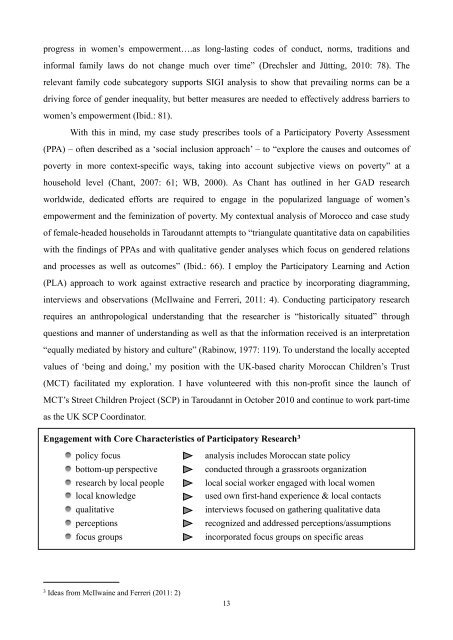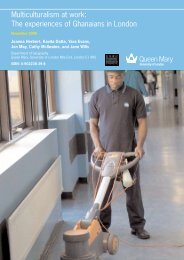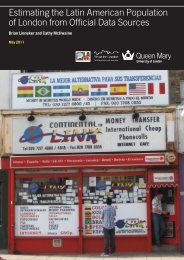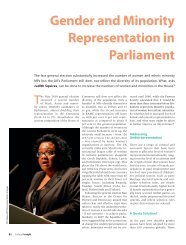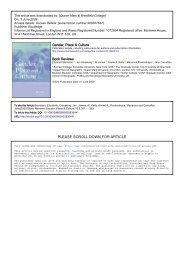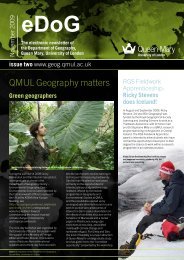Women's Empowerment and the Feminization of Poverty among
Women's Empowerment and the Feminization of Poverty among
Women's Empowerment and the Feminization of Poverty among
- No tags were found...
Create successful ePaper yourself
Turn your PDF publications into a flip-book with our unique Google optimized e-Paper software.
progress in women’s empowerment….as long-lasting codes <strong>of</strong> conduct, norms, traditions <strong>and</strong>informal family laws do not change much over time” (Drechsler <strong>and</strong> Jütting, 2010: 78). Therelevant family code subcategory supports SIGI analysis to show that prevailing norms can be adriving force <strong>of</strong> gender inequality, but better measures are needed to effectively address barriers towomen’s empowerment (Ibid.: 81).With this in mind, my case study prescribes tools <strong>of</strong> a Participatory <strong>Poverty</strong> Assessment(PPA) – <strong>of</strong>ten described as a ‘social inclusion approach’ – to “explore <strong>the</strong> causes <strong>and</strong> outcomes <strong>of</strong>poverty in more context-specific ways, taking into account subjective views on poverty” at ahousehold level (Chant, 2007: 61; WB, 2000). As Chant has outlined in her GAD researchworldwide, dedicated efforts are required to engage in <strong>the</strong> popularized language <strong>of</strong> women’sempowerment <strong>and</strong> <strong>the</strong> feminization <strong>of</strong> poverty. My contextual analysis <strong>of</strong> Morocco <strong>and</strong> case study<strong>of</strong> female-headed households in Taroudannt attempts to “triangulate quantitative data on capabilitieswith <strong>the</strong> findings <strong>of</strong> PPAs <strong>and</strong> with qualitative gender analyses which focus on gendered relations<strong>and</strong> processes as well as outcomes” (Ibid.: 66). I employ <strong>the</strong> Participatory Learning <strong>and</strong> Action(PLA) approach to work against extractive research <strong>and</strong> practice by incorporating diagramming,interviews <strong>and</strong> observations (McIlwaine <strong>and</strong> Ferreri, 2011: 4). Conducting participatory researchrequires an anthropological underst<strong>and</strong>ing that <strong>the</strong> researcher is “historically situated” throughquestions <strong>and</strong> manner <strong>of</strong> underst<strong>and</strong>ing as well as that <strong>the</strong> information received is an interpretation“equally mediated by history <strong>and</strong> culture” (Rabinow, 1977: 119). To underst<strong>and</strong> <strong>the</strong> locally acceptedvalues <strong>of</strong> ‘being <strong>and</strong> doing,’ my position with <strong>the</strong> UK-based charity Moroccan Children’s Trust(MCT) facilitated my exploration. I have volunteered with this non-pr<strong>of</strong>it since <strong>the</strong> launch <strong>of</strong>MCT’s Street Children Project (SCP) in Taroudannt in October 2010 <strong>and</strong> continue to work part-timeas <strong>the</strong> UK SCP Coordinator.Engagement with Core Characteristics <strong>of</strong> Participatory Research 3policy focusbottom-up perspectiveresearch by local peoplelocal knowledgequalitativeperceptionsfocus groupsanalysis includes Moroccan state policyconducted through a grassroots organizationlocal social worker engaged with local womenused own first-h<strong>and</strong> experience & local contactsinterviews focused on ga<strong>the</strong>ring qualitative datarecognized <strong>and</strong> addressed perceptions/assumptionsincorporated focus groups on specific areas3Ideas from McIlwaine <strong>and</strong> Ferreri (2011: 2)13


